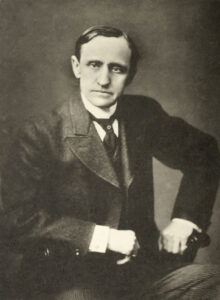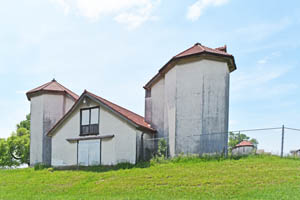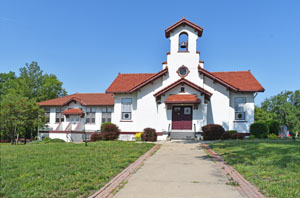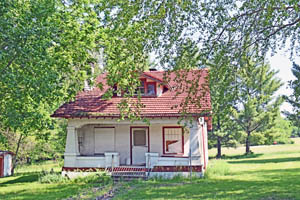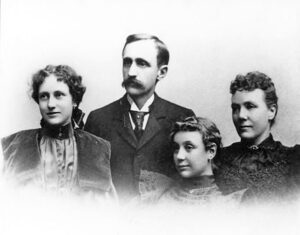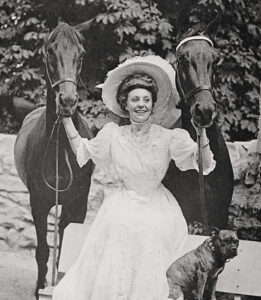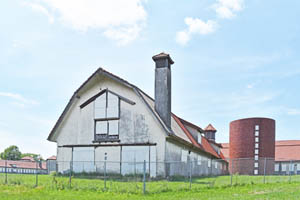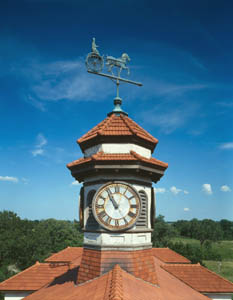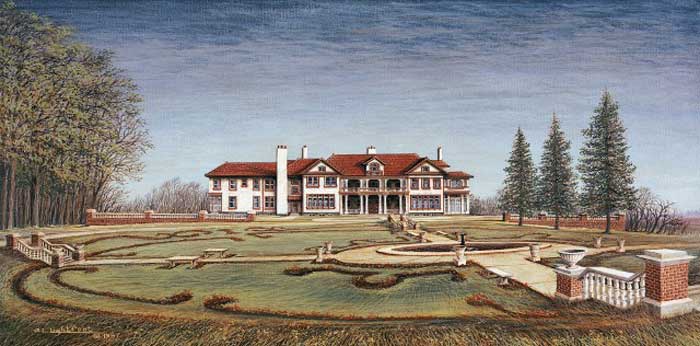
Mansion at Longview Farm, Lees Summit, Missouri. Photo courtesy Sunflower Management Group, Kansas City.
Longview Farm in Lee’s Summit, Missouri, was built by millionaire lumber baron Robert Alexander Long. Years after Long began the Long-Bell Lumber Company in Columbus, Kansas, in 1875, he relocated his family and company to Kansas City, Missouri, in 1891.
In 1913, at the age of 63, having already accomplished phenomenal goals, Long made plans to build Longview Farm. Having a lifetime interest in horses and farm living, he planned a comprehensive self-sufficient community that provided for all the needs of its residents.
To gain sufficient acreage to accommodate the facilities, purchasing 16 separate farms from private owners was necessary. The result was a rectangular tract, one and one-half miles wide and one and three-fourths miles long. The site he selected in Lee’s Summit, then approximately 20 miles southeast of Kansas City, could be reached within an hour by car. Because of its high elevation on land that commanded extraordinary countryside views, Long was exceptionally pleased, as it met all of the specifications that would make Longview Farm the finest in the land.
Enlisting the professional services of Kansas City architect Henry F. Hoit, who had designed his Kansas City home and business building, and renowned landscape architect George F. Kessler, Long set about the construction of the farm.
Construction began in 1913 with 2000 workers, including 50 Belgian craftsmen and 200 Sicilian stonemasons. Construction of the farm buildings, grading of roads, excavating the ten-acre lake, laying pipe, setting trees and shrubbery, changing of water courses, and digging post holes for the nine-mile-long fence to surround the farm, employed some 250 people. Long, fascinated by the project, personally supervised much of the work, taking up quarters in a canvas tent set up on the grounds for him. By May 1914, much of the farm was finished, and the family residence was ready for occupancy on June 1.
When construction was entirely completed in 1916, the farm, mansion, and over 50 other structures were built on 1,780 acres resulting in what came to be known as the World’s Most Beautiful Farm. The million-dollar farm boasted the primary residence with formal gardens; barns for the show horses, work horses, dairy animals, and hogs; a chapel/schoolhouse; numerous dwellings for the over 200 farm employees; a racetrack, grandstand, and clubhouse; and a powerhouse. Each building was visually interrelated with its red tile roofs and stucco exteriors. Many of the buildings featured elaborate cupola structures and custom copper weathervanes. The buildings were carefully sited to take maximum advantage of the high land elevation, employing long vistas of incomparable views and providing ventilation and light for the monumental farm structures.
Approximately 800 acres were devoted to cultivating oats, corn, wheat, and soybeans. The remaining acreage was given to the primary residence and gardens; the lake; those buildings associated with the dairy, hog production, and horse breeding aspects of the farm; and to commercial greenhouses, Long’s goal in planning Longview was to lay out the farm and design the buildings to both maximize production and provide an overall efficiency to the operation.
Employing an average of 175 people, the farm consisted of all the amenities to care for the Longs prize horses and a modern dairy, including prize Jersey cows, that produced enough milk for the farm, community, and charities. Hogs, chickens, farm land for food, greenhouses, and a manicured main yard of 225 acres were all part of the expansive farm. Scenic and self-sufficient, the farm and dairy even included underground electricity and a 100,000-gallon water tower.
The size of that community, located in a rural area, necessitated that some facilities and institutions be brought to the farm. Long’s goal was to provide a comfortable place for his employees to live, and he wanted the farm to have every convenience they would get if they stayed in the city.
Designed to be self-sufficient, the farm had plants for heating and electricity, a water system, and even a telephone system. It, therefore, offered a wide range of employment opportunities, and in addition to farm help, the farm included blacksmiths, plumbers, carpenters, and other trades.
A variety of residential accommodations were provided for the employees. The managers of the various farm departments had their own houses. Several cottages were provided for married workers, and a boarding house called the “Hotel’,'” was provided for single men.
“I want to make this place so attractive to them that they will like to stay here and never want to leave.”
— Robert A. Long
A community spirit was created in a variety of ways. Group transportation was provided to nearby Lee’s Summit on Saturdays for shopping and recreation. Baseball games between different farm departments and other athletic activities were popular.
A combination chapel/school became a social center for the farm’s employees. The structure could seat 200 people and had a basement social hall and Sunday School classrooms. The chapel frequently offered movies and plays for the employees’ entertainment. It was described as “Mission” in its style and equipped with an “old-fashioned belfry.” In addition to the farm’s regular employees, a summer colony of 11 underprivileged who Long invited to spend some time on the farm made use of the facility.
The essential design elements of stucco walls and red tile roofs provided continuity. The perimeters of the farm’s boundaries were identified by nine miles of whitewashed post and rail fencing. Cypress for the fence was sawed and planed in Long’s lumber mills in Louisiana. The fence posts were eight feet high, and each rail was twelve feet long. Constructed without nails or pegs, the end of each rail was mitered so it fits in mortised post holes. The fence was constructed for $15,000.
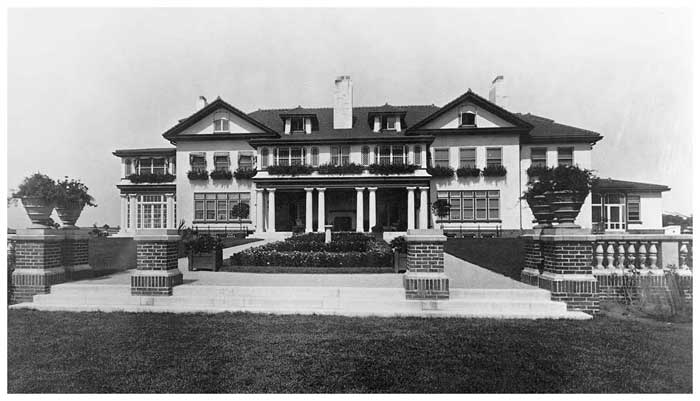
Backside of Mansion at Longview Farm in Lees Summit, Missouri.
Seven miles of gravel lanes interlaced the farm, capitalizing on the beauty of the rolling terrain. The road leading from the entrance gate, past the Show Horse Barn, to the primary residence was given a more formal treatment. This gently curving road was 60 feet wide with 16 feet of parkway on each side, flanking a paved 28-foot wide center section. Two rows of elm trees were planted on each side of the lane. Electric light standards, eight-feet high supported round glass globes providing further embellishment. A balustrade marked the perimeter of the grounds of the primary residence, extending 75 feet on all sides.
No expense was spared on the 22,000-square-foot showplace mansion with 48 rooms, six fireplaces, 14 bedrooms, and ten baths. The main facade of the main house was 138 feet in length, and a projecting colonnaded porch provided the focus for the center bay. Its features include stucco wall surfaces, red tile roofs, symmetrical plans, Tuscan columns, and exterior porches with windows directing maximum light to the interiors. The residence was appointed with elaborate furnishings and featured ornate moldings and fine woodwork. Long even installed a $15,000 pipe organ. Massive fireplaces were a standard feature in the house. Dressing rooms were provided for all of the bedrooms, which were located on the second floor. Each of the bedrooms opened onto an enclosed porch, giving the occupant a grand view of the landscape and formal gardens and allowing a great deal of light into the interior. It also claimed the first central vacuum system west of the Mississippi River and steam heating.
The highlight of the landscaping scheme at Longview Farm is the lake and pergola. The 20-acre lake was approximately 300 feet east of the primary residence, planned to be visible from the east porch. The lake had both a functional and a recreational purpose. After the lake bed was excavated, it was filled with water from the Little Blue River, located at the northwest corner of the farm. A pumping plant carried the water through six-inch pipes into the lake. A filter house at the south end of the lake could purify up to 50,000 gallons of water daily for use around the farm. The purified water was stored in a 100,000-gallon steel tank located on the highest point of ground on the farm. The lake was also used for boating, and the small craft could be moored on concrete blocks adjacent to the colonnaded pergola at the north end of the lake. A boat house once stood on the west side of the lake. The depth of the lake at the dam was 40 feet.
Shortly after the farm was built, two greenhouses were erected to provide flowers and shrubbery for Longview and the Long estate in Kansas City. All of the residential structures at Longview had numerous window boxes for flowers, and formal gardens were an integral part of the farm. Longview developed such a reputation for its flower production that eventually, the greenhouses were expanded, and the commercial distribution of an average of 2,000 blooms daily were provided through a wholesale outlet in Kansas City, including sweet peas, roses, and chrysanthemums.
A circular drive approached all of the major groups of buildings. The primary residence was oriented toward a circular drive encompassing a grassy island. Immediately north of the drive, the circle was repeated on a grand scale in a formal garden with a simple pedestal fountain set within a retaining basin.
The undisputed head over the horses was Loula Long, who shared a love for horses with her father. She married Pryor Combs, also a horse lover, on July 30, 1917. It was said that she would agree to marry him only if he agreed to live at Longview Farm
Robert A. Long died on March 15, 1934. Though he spent a relatively short period of his life enjoying this masterpiece of rural harmony, his daughter Loula Long Combs, loved breeding, training, and showing horses. Gaining an international reputation as a luminary equestrienne, when brought an almost legendary prominence to the farm. She showed her horses across the United States and Canada, including Madison Square Garden, where she was one of the only women to enter the ring. She continued to appear at the American Royal in Kansas City yearly, well into her eighties.
The Great Depression instigated Longview Farm’s slow decline, with Long’s lumber business and the farm both taking financial hits. The Longview dairy business was the first to decline, and in 1935, the show cattle were sold as more emphasis was directed toward commercial dairy. At that sale, 174 heads of purebred Jersey cattle brought $48,000.
Staffing issues followed during World War II, and the farm’s commercial dairy operation ceased. At that time, the farm’s personnel went from 175 employees to less than 100. In an auction conducted in April 1944, the Longview dairy herd of Guernseys, Holsteins, and Jerseys was sold, and the farm shifted its attention to beef cattle. By the mid-20th century, most fields were rented out to farmers, and the Long sisters donated 146 acres to Longview Community College in 1968. At that time, both Loula Long Combs and her older sister Sally America Long Ellis, were widowed and lived in the mansion. They both died in 1971.
The land was further divided a decade later when the U.S. Army Corps of Engineers acquired 950 acres for Longview Lake, part of the Little Blue River Project, for flood control, recreation, and fish and wildlife conservation. At that time, many deteriorating buildings were removed to repurpose the materials for shelter houses and structures.
Other parcels were sold and became nearby residential communities.
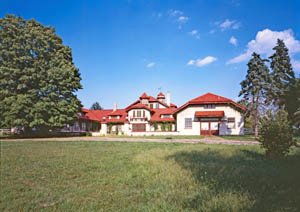
The Show Horse Barn at Longview Farm became the Longview Elementary School. Photo by the Historic American Buildings Survey.
In October 1985, Longview Farm was listed on the National Register of Historic Places. The area comprised 325 acres of the original farm and 17 buildings and structures, including the primary residence, the show horse barn, and the dairy barn complex. The land surface in the nomination also represented the landscaping design, including farm lanes, fencing, a lake, formal gardens, ornamental entrance markers, and lighting fixtures.
The Longview Farm Elementary School became a realization in 2005 after the Longview Farm show-horse arena was converted into the school.
David Gale bought the remaining land of Longview Farm to establish a 260-acre project community for $330 million called New Longview with historic preservation in mind. A mixed-use retail, office, and residential neighborhood, the community includes many historically restored buildings, a 50-acre park, and the 146-acre Longview Community College campus.
Longview Mansion was renovated as a wedding and event venue in 2018.
The community borders the 4,800-acre Longview Park and the 900-acre Longview Lake.
©Kathy Alexander/Legends of America, June 2023.
Also See:
Historical People of Kansas City
Sources:
KC Library
National Register of Historic Places Nomination
Wikipedia – Longview Farm
Wikipedia – Longview Lake

